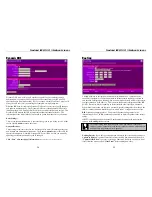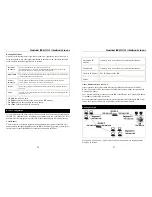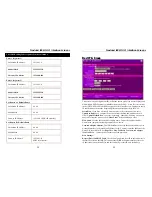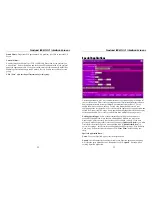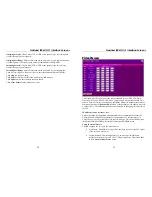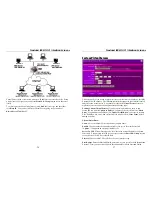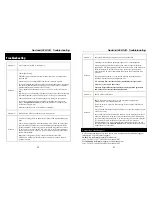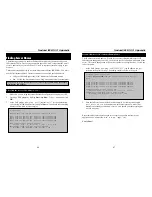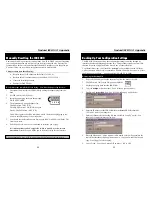
Nexland ISB SOHO: Appendix
52
Glossary
DHCP
Dynamic Host Configuration Protocol is a network configuration protocol that lets a
router or other device assign IP addresses and supply other network configuration
information to computers on your network.
DSL
Digital Subscriber Line. This, with Cable and Wireless, are new forms of Digital
connections to the Internet. They are much faster than a typical analog connection
(33.6k or 56k modems). There are 2 main forms, ADSL and SDSL (Asynchronous
and Synchronous). ADSL is faster receiving than sending information while SDSL
offers equal speed in both directions.
Firewall
A means to protect your local network of computers from the outside (typically the
Internet). This prevents intruders from viewing information on your LAN. Firewalls
come in two flavors: hardware and software. The software firewalls are usually
running on the network server (main computer on the network). Hardware firewalls
are boxes hooked up to your modem or router.
Gateway/Router
A place where information is routed through before entering another section of the
network. Typically, a routing point between your local network and the Internet.
Hub
A connection point for multiple computers on the network. Like a splitter with
several ports. A hub is different then a switch in that packets are sent to every port
on the unit (only computers requesting the packets actually read them).
IP
Internet Protocol. The main protocol for communicating over the Internet. It is not
secure in any way. In addition to the information they contain, IP packets contain
source and destination addresses to direct their travel over the Internet.
IPsec
Internet Protocol Security. An encrypted method of transmitting data from one
location to another. It is the most secure way of sending data over the public
Internet. The packets would take several supercomputers decades to crack. IPsec
was developed fairly recently.
L2TP
Another method of encrypted communication over a network. The L2TP protocol
opens a "tunnel" or safe pathway for information that can link to multiple locations
over the Internet. This is not as secure as IPsec.
LAN
Local Area Network. The term used to describe a network of computers in one
location, like an office.
Modem
Modulator/demodulator. Device used to convert a digital signal (on or off, 1 or 0) or
"computer speak" to an analog signal for transmission over standard telephone lines.
A modem at the other end of the connection converts the analog signal back to a
digital signal.
NAPT
A combination of the NAT & PAT acronyms. Network Address and Port
Translation. The ISB product line uses NAPT for firewall protection.
Nexland ISB SOHO: Appendix
53
NAT
Network Address Translation. The method of converting IP addresses from multiple
computers on a LAN to a single address that represents the entire LAN to the
outside world and vice versa. This lets those computers share one Internet
connection. The process of converting addresses also provides an innate firewall
protection to the local computers.
PAT
Port Address Translation. Same as NAT but translates ports numbers as well. Each
computer has over 65,000 ports where information can enter over the network
connection. Some Internet sharing devices do not do PAT which leaves computers
on the LAN open to hacking through their ports.
PPPoE
Point to Point Protocol over Ethernet - A type of DSL Internet connection where the
user "dials-up" his service. ISPs use PPPoE because it allows them to integrate DSL
service easier into their existing Analog dial-up networking equipment. The ISB
allows you to use PPPoE transparently and efficiently.
PPTP
Point-to-Point Tunneling Protocol. An encrypted method to transmit data from one
location to another. It's not nearly as secure as IPsec. A powerful personal computer
can crack the code in a matter of a couple days.
Protocol
A defined format for an information packet sent over a network (like the Internet).
There are many different protocols currently defined. For example the HTTP
protocol is used to view web sites and POP3 is used for e-mail. There are sometimes
protocols within protocols; this is the case with encrypted protocols like IPsec. IPsec
packets can contain HTTP packets and so on.
Subnet Mask
A 32-bit address mask that identifies which bits of an IP address represent network
address information and which bits represent network node (segment) identifier
information.
TCP/IP
A protocol used over networks. Entire Books have been written on it. Defined in
RFC 1055.
VPN
Virtual Private Network. The term used to describe the transmission of data over the
public Internet with encrypted packets. Since you are using a secure means of
transmittal, your network connection between point A and Point B is "virtually"
private. This is as opposed to an actual private network, which is substantially more
expensive to implement from one location to another.

